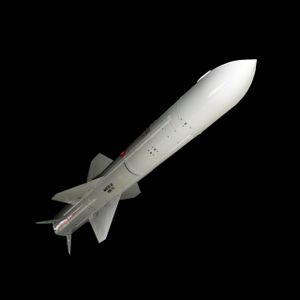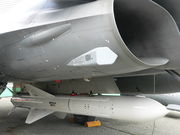Exocet
| Exocet | |
|---|---|
 An AM39 aircraft-launched Exocet |
|
| Type | Medium-range anti-ship missile |
| Place of origin | France |
| Service history | |
| In service | 1979 |
| Production history | |
| Manufacturer | Aérospatiale's division MBDA |
| Specifications | |
| Weight | 670 kilograms (1,500 lb) |
| Length | 4.7 metres (15 ft 5 in) |
| Diameter | 34.8 centimetres (1 ft 1.7 in) |
|
|
|
| Warhead | 165 kilograms (360 lb) |
|
|
|
| Engine | solid propellant engine
turbojet (MM40 Block 3 version) |
| Wingspan | 1.1 metres (3 ft 7 in) |
| Operational range |
70–180 kilometres (43–110 mi; 38–97 nmi) |
| Flight altitude | Sea-skimming |
| Speed | 315 metres per second (1,030 ft/s) |
| Guidance system |
Inertial and active radar |
| Launch platform |
multi-platform:
|
The Exocet is a French-built anti-ship missile whose various versions can be launched from surface vessels, submarines, helicopters and fixed wing aircraft. Hundreds were fired in combat during the 1980s.
Contents |
Etymology
The missile's name was given by M. Guillot, then the technical director at Nord Aviation, after a French word for flying fish (Exocoetidae).[1]
Description

The Exocet is built by MBDA, a European missile company. Development began in 1967 by Nord as a ship-launched missile named MM 38. A few years later Aerospatiale and Nord merged. The basic missile body design was based on the Nord AS30 air to ground tactical missile. The air-launched Exocet was developed in 1974 and entered service with the French Navy five years later.[2]
The relatively compact missile is designed for attacking small- to medium-size warships (e.g. frigates, corvettes, and destroyers), although multiple hits are effective against larger vessels, such as aircraft carriers.[3][4] It is guided inertially in mid-flight and turns on active radar late in its flight to find and hit its target. Its solid propellant engine gives the Exocet a maximum range of 70 kilometres (43 mi; 38 nmi). The solid-propellant engine was replaced on the Block 3 MM40 ship-launched version of the missile with a solid-propellant booster and a turbojet sustainer engine which extends the range to 180 kilometres (110 mi; 97 nmi). The submarine-launched version places the missile and a naval booster inside a launch capsule.
The Exocet has been manufactured in a number of versions, including:
- MM38 (surface-launched)
- AM38 (helicopter-launched - tested only)[5]
- AM39 (air-launched)
- SM39 (submarine-launched)
- MM40 (surface-launched)
The chief competitors to the Exocet are the U.S.-made Harpoon, and the Chinese Yingji series.
MM40 Block 3
The newest MM40 version (MM40 block 3) has an improved range of 180 kilometres (110 mi; 97 nmi) through the use of a turbofan engine, and includes four air intakes to provide continuous airflow to the engine during high-G maneuvers.
The Block 3 missiles accepts GPS guidance system waypoint commands, which allow them to attack naval targets from different angles and to strike land targets, giving them a marginal role as a cruise missile. The Block 3 Exocet is lighter than the previous MM40 Block 2 Exocets.[6][7][8]
The 45 Block 3 Exocets were ordered by the French Navy in December 2008. These are not to be new productions but the conversion of older Block 2 missiles to the Block 3 standard. The first firing of the Block 3 from a warship took place on March 18, 2010, from the French Navy air defense frigate Chevalier Paul. Besides the French Navy, the Block 3 has been ordered by the navies of the UAE, Qatar, Oman and Morocco.[9]
History
Falklands Conflict



In 1982, during the Falklands War, Exocet became noted worldwide when an Argentine Navy Super Etendard warplanes carrying the AM39 Air Launched version of Exocet caused irreparable damage to the Royal Navy destroyer HMS Sheffield on 4 May 1982; and when the 15,000 ton merchant ship Atlantic Conveyor was struck by two Exocet anti-ship missiles on 25 May. Two MM38 ship-to-ship Exocet missiles that were removed and transferred from the old destroyer ARA Seguí, a retired US Sumner class, to an improvised launcher for land use [10] caused damage to the Destroyer HMS Glamorgan on 12 June.
While the Argentineans claimed that an Exocet-armed Super Etendard attack on 30 May damaged the aircraft carrier HMS Invincible, this claim is unfounded, due to the continued air operations of Invincible with no signs of damage. During the conflict the Argentinian Government several times claimed incorrectly that it had damaged several ships, with multiple previous claims to have damaged or sunk the aircraft carriers HMS Invincible and HMS Hermes, the two most important British warships there, and shot down Sea Harriers, due to some combination of the natural confusion of battle and propaganda purposes.
The Exocet that struck HMS Sheffield impacted on the second deck, 2.4 metres (7 ft 10 in) above the waterline and penetrated deeply into Sheffield's control room,[11] near to the forward engine room, cracking the hull open roughly 1.2 by 3 metres (3.9 by 9.8 ft). It appears that the warhead did not explode.[12] Accounts suggest that the initial impact of the missile destroyed the ship's on-board electricity generating systems and fractured the water main, preventing the anti-fire mechanisms from operating and dooming the ship to be consumed by the fire. The loss of Sheffield was a shock to the British.
The crew of Sheffield believed that the missile exploded. The official Royal Navy Board of Enquiry Report, however, stated that evidence indicates that the warhead did not detonate. During the 4.5 days that the ship remained afloat, five salvage inspections were made and a number of photographs were taken. Members of the crew were interviewed, and testimony was given by Exocet specialists (note that the Royal Navy had 15 surface combat ships that were Exocet-armed in the Falklands War). There was no evidence of explosion although burning propellant from the rocket motor caused a number of fires, which continued unchecked as a result of a punctured firemain.
The Exocet that struck Glamorgan detonated (indeed a number of crew witnessed this) on the port side of the hangar deck, punching a hole in the deck and galley below, causing fires. The missile body traveled into the hangar causing the fully fueled and armed Wessex helicopter to explode. Prompt action of the officers and men at the helm saved the ship. With less than a minute's warning the incoming missile was being tracked on radar in the operations room and bridge, as the ship was traveling at speed, a turn was ordered to present her stern to the missile.[13] The ship was heeled far over to starboard when the missile struck. The missile hit the coaming and was deflected upwards. The dent caused by the impact was clearly visible when Glamorgan was refitted in late 1982.
In the years after the Falklands War it was revealed that the British government and the Secret Intelligence Service were extremely concerned by the perceived inadequacy of the Royal Navy's anti-missile defences against Exocet missiles and its potential to tip the naval war decisively in favour of Argentine forces. A scenario was envisioned in which one or both of the force’s two aircraft carriers (HMS Invincible and HMS Hermes) would be destroyed or incapacitated by Exocet attacks, which would make recapturing the Falklands much more difficult. To contain the Exocet threat a major intelligence operation was initiated to prevent the Argentine Navy from acquiring more. The operation included British intelligence agents claiming to be arms dealers able to supply large numbers of Exocet to Argentina, diverting Argentina from pursuing sources which could genuinely supply a few missiles. France denied deliveries of Exocet AM39s purchased by Peru to avoid the possibility of them getting to Argentina [14].
Middle East

Iraq fired an estimated 200 air-launched Exocet against Iranian shipping during the Iran–Iraq War with varying levels of success. Tankers and other civilian shipping were often hit.
On May 17, 1987, the pilot of an Iraqi Mirage F-1 allegedly mistook the U.S. Navy Oliver Hazard Perry class frigate USS Stark for an Iranian tanker and fired two Exocet at the warship. The first penetrated the port-side hull. The second entered at almost the same point, and left a 3-by-4-metre (9.8 by 13 ft) gash, exploding in crew quarters. Thirty-seven sailors were killed and 21 were injured. The Stark was heavily damaged, but saved by the crew and sent back for repairs. The errant pilot was reportedly executed for his error, and his explanations for the attack are not available. Later, Iraqi officials denied that the pilot had been executed and stated that he was still alive.[15]
Operators


Current operators
 Argentina
Argentina- Argentine Navy - MM38, MM40 and AM39
 Bulgaria
Bulgaria Brazil
Brazil- Brazilian Navy - MM38, MM40 Block 2 and AM39
 Chile
Chile- Chilean Navy - MM38, AM39 and recently acquired SM39 for the Scorpène class submarine . Previously used MM40. Is unknown if the missiles were sold along with the two Condell class frigates to Ecuador
 Colombia
Colombia Cyprus
Cyprus- MM40
 Ecuador
Ecuador- MM40
 Egypt
Egypt- AM39[16], MM38 & MM40
 France
France Germany
Germany- German Navy - To be replaced with RBS 15.
 Greece
Greece- MM38, MM40 Block 2/3, AM39
 Indonesia
Indonesia- MM38, MM40 Block 2, MM40 Block 3
 Iran
Iran Iraq
Iraq Kuwait
Kuwait Libya
Libya Malaysia
Malaysia- Royal Malaysian Navy - MM38, MM40 Block 2, SM39 (on Scorpène class submarines)
 Morocco
Morocco Oman
Oman Pakistan
Pakistan- Pakistan Air Force - AM39 (on Dassault Mirage 5 naval support fighters)
Pakistan Navy - SM39 (on Agosta 90B submarines), AM39 (on Breguet Atlantic patrol aircraft)  Peru
Peru- Peruvian Navy - MM38, AM39 on ASH-3D Sea King
 Qatar
Qatar South Africa
South Africa Thailand
Thailand Turkey
Turkey- MM38[17][18]
 United Arab Emirates
United Arab Emirates Uruguay
Uruguay Venezuela
Venezuela- Venezuelan Air Force - AM39 (on Dassault Mirage 50)
 South Korea
South Korea- ROK Navy
Former operators
.svg.png) Belgium
Belgium- Belgian Navy operated Exocet on its Wielingen class frigates. Those warships were all sold in 2008
 United Kingdom
United Kingdom- Royal Navy operated Exocet until the last MM38 armed surface vessel was decommissioned in 2002.
 Georgia
Georgia
References
- ↑ Guillot, Jean; Estival, Bernard (1988). L’extraordinaire aventure de l’Exocet. Les éditions de la Cité.
- ↑ Exocet MM.40
- ↑ Norman Friedman "The Naval Guide to World Weapons Systems - 1994 Update" page 109 Naval Institute Press 1994
- ↑ "1994 Update" has a recent study by the Russians about the effect of missile boat anti-ship missiles. 3 hits to destroy a light cruiser, 1 to 2 hits for a destroyer or frigate. Russian missile boat anti-ship missile have far larger warheads than the Exocet
- ↑ Based on ship launched MM38. Only five tested in 1973 from a Super-Felon helicopter, further development then abandon for the lighter and smaller AM39. Ronald T. Pretty editor "Jane's Weapon Systems 1976" page 133
- ↑ The Command of France Exocet Block 3
- ↑ "V - CRUISE MISSILES: THE OTHER AIR BREATHING THREAT". ATTACK AIRCRAFT PROLIFERATION: ISSUES FOR CONCERN. Christopher Bolkcom and John Pike. 01 April 1993. http://www.fas.org/spp/aircraft/part05.htm. Retrieved 2009-02-10.
- ↑ Reference #9 "Sea and Navy" states that it is 870lbs lighter than the previous versions of the MM40 - I believe that number to be in error as that would be well over a half reduction in weight between the Block 2 and Block 3
- ↑ "Sea and Navy" March 19th 2010
- ↑ Latin America's Wars: The age of the professional soldier p.316
- ↑ BBC article titled: 1982: Argentines destroy HMS Sheffield
- ↑ Loss of HMS Sheffield - Board of Inquiry from the MOD (page six)
- ↑ The Glamorgan was a 5,400tn destroyer of steel and compartment construction. They were designed with the experience and lessons of WW2 including the Japanese suicide attacks, which is probably what saved it from further destruction
- ↑ The Official History of the Falkland's War
- ↑ Fisk, Robert (2005). The Great War For Civilisation: The Conquest of the Middle East. Knopf Publishing.
- ↑ SIPRI Arms Transfer Database
- ↑ "Türk Deniz Kuvvetleri" (in Turkish). www.dzkk.tsk.tr. http://www.dzkk.tsk.tr/turkce/birliktanitimi/RefakatveKarakolFilosuKomodorlugu.htm. Retrieved 2009-11-29.
- ↑ "World Navies Today: Turkey". www.hazegray.org. http://www.hazegray.org/worldnav/europe/turkey.htm. Retrieved 2009-11-29.
External links
- Manufacturer's Website (English)(French)
- Gallery of photographs of various variants of the Exocet missile (French)
- Argentine Account of the role of the Exocet in the Falklands War (English)
- Photos of Exocet damage to USS Stark (English)
- Testing of Exocet MM-40 Block 3 (English)